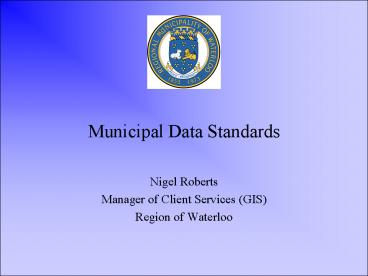Municipal Data Standards - PowerPoint PPT Presentation
1 / 14
Title:
Municipal Data Standards
Description:
Hardware Standards: Municipalities have a standard PC desktop rollout ... SIMS. WIMS. OBM 1:2,000 Mapping. Tied to funding. The province stopped funding roads in 1996 ... – PowerPoint PPT presentation
Number of Views:63
Avg rating:3.0/5.0
Title: Municipal Data Standards
1
Municipal Data Standards
- Nigel Roberts
- Manager of Client Services (GIS)
- Region of Waterloo
2
Data Standards of the 1980s and early 1990s
- The Provincial and Federal Government defined
the initial Geospatial Data Standards ie OBM,
NTDB, AMF, SLRN, RIMS, SIMS, WIMS, MBADES, ... - Why was this The Geomatics industry was young,
with very few vendors and those that existed were
highly specialized companies. - Government dictated standards by providing
dollars to adopt these standards ie
RIMS/SIMS/WIMS, OBM 12,000 with the Program
funding based upon population base
3
Data Standards of the late1990s and today
- Whose defining todays municipal standards
vendors - The government appears to be no longer in the
standards business, they do not see any direct
financial benefit in the era of cost cutting - Today the standards must be associated with end
results ie collecting asset data to support
maintenance management and work orders
4
Organizations Involved with Standards
5
Vendors Involved with Standards
6
Various Standards at Work in Municipalities
- Engineering Design and Construction
- Service Delivery Water, Garbage Collection,
- Hardware Standards Municipalities have a
standard PC desktop rollout - Software Standards Email, Word Processing, ...
7
What Municipalities Dont Understand
- Municipalities understand standardizing email,
office products, etc. - They do not understand the need to standardize
geospatial information - Information requirements stay the same even
though the technology using this information
changes rapidly.
8
Without Clear Standards.
Municipalities end up managing data
Not their Assets
9
Data Standards of Old
- RIMS
- SIMS
- WIMS
- OBM 12,000 Mapping
- Tied to funding
- The province stopped funding roads in 1996
- The province stopped cost sharing digital mapping
in 199???
10
What has happen to Roads Data?
- Since 1996 municipalities have been left to their
own to collect and maintain information about
their roads assets. - Many municipalities stopped collecting and
maintaining their roads information. Their roads
deteriorated and their lifecycle has been
reduced. - Others have migrated their data to other systems
(Hansen, MIDS, ITX, ) - Last summer the OGRA surveyed municipalities on
their roads data
11
Why municipalities need this information
- Enables them to rehabilitate roads intelligently
to increase the roads life before complete
reconstruction is required - Monitor road conditions
- Budget preparation
- Accountable to their clients
12
Why are standards not working - Part I
- No financial incentives for municipalities to
adopt information / data standards - There is no one coordinating body for geospatial
data standards - Software / Application requirements are defining
data standards
13
Why are standards not working - Part II
- Data standards do not directly resolve municipal
needs I.e. Hansen provides a standard schema for
data storage and collection of assets, but it is
the add ons that are the incentive for
municipalities (work orders, maintenance
management, relationships between assets, GIS
link, reporting, ) - Easier data conversion down plays need for
standards
14
Opportunities for Standards
- OPENGIS Consortium (multi vendor participation)
- Digital Plans of Subdivision
- MIDS Municipal Infrastructure Data Standard
- Used by a number of municipalities and supported
by the Tri-Committee (OGRA, MEA, APWA) - CAD Standards
- Used by a number of municipalities and supported
by the Tri-Committee (OGRA, MEA, APWA) - RISWG Planning Data Standards
- LIO (Land Information Ontario), MNR































